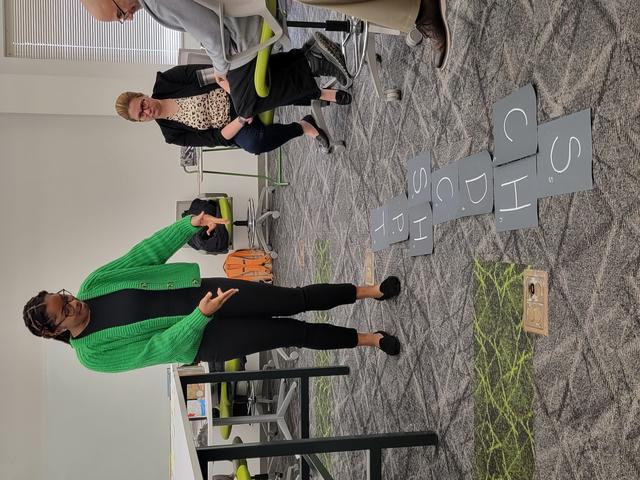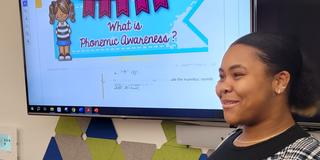
Central State University ramps up program to teach future educators how to teach reading

Above: Central State University preservice teacher candidate Jahari Hannah introduces research on the importance of phonemic awareness, hearing sounds in language, as a foundational skill for teaching students to read.
A recent report indicated that fewer than half of Ohio’s elementary school teachers graduated from higher education institutions whose teacher prep programs received a satisfactory “A” or “B” according to standards analyzed by the Fordham Institute. Now, Central State University is renewing its commitment to bolstering its College of Education courses that teach future teachers how to teach effectively.
The Fordham Institute’s report is especially pertinent to Central State students and faculty, as it found that Black, Hispanic, and poverty-stricken students, in particular, are more impacted by the low institutional grading.
This widely distributed study comes on the heels of Ohio Gov. Mike DeWine’s prodding of state legislators to require K-12 schools to utilize specific teaching practices, such as those that would demand more phonics and reading skills.
“We are doing what we can to prepare our students to become licensed teachers,” said Associate Professor of Reading/Literacy Sandra Sumerfield, Ed.D.
Sumerfield, a native of Cincinnati, has been spearheading Central State’s ad hoc program to prepare College of Education students for their Ohio state reading instruction licensure testing since first joining the faculty six years ago.
“I love the vision of serving and helping at Central State,” Sumerfield said. “I just feel like this is my place. At the time I was interviewed, the information I got about the school and the feeling I got about it is what really pulled me in.”
Those who wish to teach in Ohio must undergo a full licensure process after providing proof of higher education coursework completion. As determined by the Department of Education, this licensure process includes a 12-hour series of classes in reading instruction. As required by law, such classes as part of an Educator Preparer Program (EPP) include those that, for instance, showcase an ability to teach phonics.
“It’s a pretty serious business,” Sumerfield said, “which is why we work so hard to prepare our students by imparting to them such skills as explicit and implicit instruction. This will allow them to have the ability to directly teach information and help kids understand how to apply that information and how to support children when they are struggling to meet the needs of every individual learner.”
For Sumerfield and her colleagues in the College of Education, “It’s not just, ‘Here’s some information and this is what you need to do with your students.’ The reality is that all students are going to have a range of abilities, and our future teachers really need to understand the scope and sequence of reading development so they can help their students individually.”
Sumerfield’s goal with her reading instruction licensure preparation courses for Marauders is to help them in being able to “meet the needs of every student they may have. That’s what we’re focused on.”

With her master’s degree in Reading Intervention and doctorate in Reading Education, Sumerfield was the ideal candidate to take on the role of running the “reading program,” as it is known within the college at Central State.
“I was hired because of my background,” Sumerfield explained. “And, so, I became the person who’s been developing, aligning, and keeping the program — really, a block of classes — going strong.”
Because the state frequently changes licensure protocol, Sumerfield and her colleagues in the College are tasked with continuing to adapt their reading programs to adequately prepare Marauders for their licensing prep work.
“There’s been a big shift that will take place by the end of the summer,” Sumerfield said. “Whereas before your teaching license allowed you to teach three years old through third grade, aka ‘early childhood,’ now you’ll be able to teach through ‘primary education,’ which is pre-K through fifth grade. It’s a big shift, especially when you’re talking about reading. And I’m working a lot on making sure our program is in alignment with that shift.”
The reading program for future teachers in Central State’s traditional student body that Sumerfield leads at Central State includes two each fall — Introduction to Teaching Reading and Children’s Literature — and two in the spring — Language & Literacy and Phonics & Reading. Central State Global students can take these classes at any time throughout the year.
“What we’re doing with the reading program at Central State is important to me because I look at the world we’re living in right now, and I look at people who don’t understand each other,” Sumerfield said. “The fact is that we’re all different, and I talk to my students about this. As a teacher, you open yourself up to everybody’s lens. But you also have a special responsibility there. That’s why I always teach my students that we’re not here to teach students what to think; we’re here to teach them how to think."


